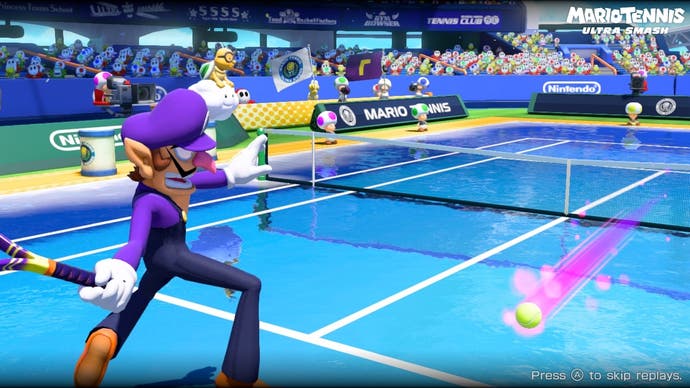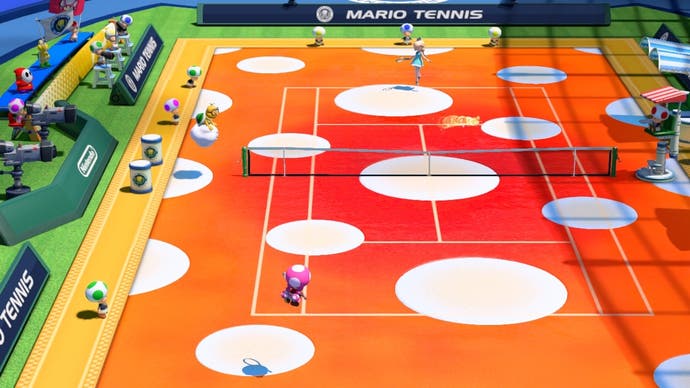Mario Tennis: Ultra Smash review
Deucey lemon.
November: not exactly the most auspicious month in the tennis calendar. Sure, you've got the Barclays ATP World Tour Finals, with a potential purse of $2 million plus for an undefeated champion. But I doubt that sum factored high on Nintendo's list of reasons to publish such a sunny, summery game at a time of year when it's permanently dark and cold, and any mention of Wimbledon fever is more likely to pertain to an unexpected outbreak of bacterial infections in south west London.
Yet oddly enough, Ultra Smash follows a great Nintendo tradition of tennis games releasing in November. The GameCube's Mario Power Tennis debuted eleven years ago this month. And the great Mario Tennis 64 simultaneously launched in Europe and the US in November 2000. In other words, you'd be wrong to think that the release date suggested this would be a hurriedly assembled schedule-filler. The game itself does a good enough job of that.
Perhaps the most damning evidence came on the day review code arrived. I picked my son up from school at half three, and between us, we'd unlocked every court surface and character - including the more powerful star variants - by five. That's including a break for snacks, too.

You may have noted how I said 'court surface' instead of 'court'. There's a very good reason for that: Ultra Smash has only one arena. A single stadium bathed in perpetual sunshine, packed with the same Koopa Troopas and Shy Guys in the crowd for every game, cheering and applauding as the winner is announced: "Game, set and match - Server!" Yes, even with such a limited roster of players, no one's name gets called out, let alone engraved on a trophy (there are no trophies either, of course).
Corners have been cut almost everywhere. Replays draw from an extremely limited selection of camera angles. The animation for Ultra Smash shots is the same every single time; likewise when you collect a Mega Mushroom; ditto when the game ends and the audience holds up sheets of coloured paper that form an image of the victor.
None of this is as important as how the game plays, of course. But the cumulative result is that it all feels slightly inconsequential. It is, as it always has been, highly satisfying to squeeze past a tough opponent after a tight game where the outcome remains in doubt until the final few points. But that sense of achievement is diminished by the identical way each win is received, by the same animations and camera angles for your best shots. I can't think of the last Nintendo game where the lack of time and resources for the developer was so clearly apparent.
As early as the main menu screen, you get an inkling that there's not much game here. Mega Battle gets an icon twice as large as any other option, a sign that this is the mode Camelot wants you to play first. Yet the only difference between this and Classic Tennis is that courtside Toads will occasionally throw in a Mega Mushroom: as you'd expect, these make your player (and their opponent) much larger, and their shots faster and harder. Essentially, it's an option packaged and presented as an entirely separate mode.

Scandalously, there are no tournaments either. The closest to that is Knockout Challenge, which is simply a series of matches against opponents of increasing difficulty. After 15 wins, you'll face off against Bowser, who is super-sized from the off. Beat him, and the cycle simply repeats. Again, the absence of any kind of context robs you of any tangible sense of achievement. Your stats might tell you you've won 23 consecutive games with Sprixie Princess (who would be the only surprise of the quartet of unlockable characters if Nintendo hadn't already given her a promotional trailer) but the figure means very little. Elsewhere, there's a mini-game called Mega Ball Rally, which - and you might want to sit down for this - asks you to keep a rally going with a Mega Ball. It is precisely as boring as it sounds.
Finally, there's online. Here, you can choose between singles and doubles matches, playing 'serious' matches which affect your numerical ranking, or 'relaxed' games which don't. You can pick between the two variants of Classic Tennis (one of which strips things down to the very basics) or Mega Battle, and choose the length of your match. Casual is a first-to-seven tiebreak match, and a two-game one-set match is classed as Extended - despite often finishing sooner than Casual matches. And that's your lot.
All told, that's pretty miserly for a full-price game. But for all that it could certainly do with more meat on its bones, it plays as well as Mario Tennis ever did. It borrows the Chance Shots of the 3DS's Mario Tennis Open, where coloured circles will randomly appear on court during a rally, allowing you to hit with more power or slice assuming you play the shot type corresponding to the colour. Clever players will use this to bluff opponents, charging up a slice only to hit a topspin winner, or setting themselves up for a drop shot and lobbing their opponent as they advance toward the net.
With the exception of the final two unlockables - one of which changes the surface type on your opponent's side with each successful chance shot or smash - the nine court types are less gimmicky than Mario Power Tennis. There are palpable differences between them, too: the low-bouncing desert surface encourages drop shots, while playing on carpet sees the ball move much faster.

And if the Mega Mushrooms tilt the scales a bit, they're not as ludicrously overpowered as the special shots in the GameCube game. The signature Ultra Smash only gets a cutscene in replays rather than interrupting the match. Though it's disappointing to see so many recycled assets and animations, this is a beautiful looking game at times: crisp, bright and characterful, with no danger of a frame ever being dropped.
It's true that only the two unlockable difficulties offer any kind of resistance when playing against AI opponents, and that too many points end with a stretched mishit that is punished by a cross-court smash. But those with fond recollections of the N64 game might just find a four-player game that lives up to those rose-tinted memories.
Still, it's hard to shake the feeling that it could have been so much more.
Mario Tennis Ultra Smash feels stingy. It's a disappointment akin to visiting a favourite restaurant and ordering your usual, only to find the portions are half the size they were last time you came. It tastes as good as you remember, but you still come away feeling short-changed.
Such a modest offering is hard to recommend. November mightn't be the most auspicious month in the tennis calendar, but when it comes to games, we're rather spoilt for choice. At this time of year, there are many better - and better value - options than this.

